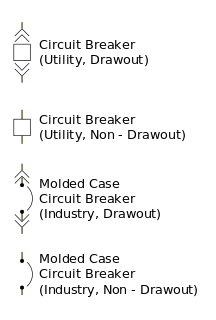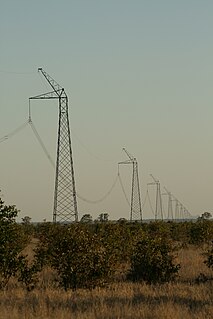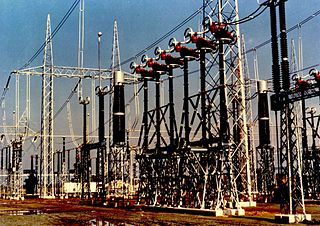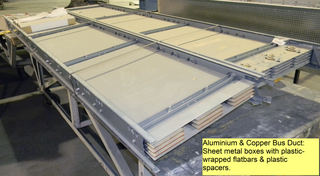

A padmount or pad-mounted transformer is a ground mounted electric power distribution transformer in a locked steel cabinet mounted on a concrete pad. Since all energized connection points are securely enclosed in a grounded metal housing, a padmount transformer can be installed in places that do not have room for a fenced enclosure. Padmount transformers are used with underground electric power distribution lines at service drops, to step down the primary voltage on the line to the lower secondary voltage supplied to utility customers. A single transformer may serve one large building, or many homes.

A distribution transformer or service transformer is a transformer that provides the final voltage transformation in the electric power distribution system, stepping down the voltage used in the distribution lines to the level used by the customer. The invention of a practical efficient transformer made AC power distribution feasible; a system using distribution transformers was demonstrated as early as 1882.

Electric power distribution is the final stage in the delivery of electric power; it carries electricity from the transmission system to individual consumers. Distribution substations connect to the transmission system and lower the transmission voltage to medium voltage ranging between 2 kV and 35 kV with the use of transformers. Primary distribution lines carry this medium voltage power to distribution transformers located near the customer's premises. Distribution transformers again lower the voltage to the utilization voltage used by lighting, industrial equipment or household appliances. Often several customers are supplied from one transformer through secondary distribution lines. Commercial and residential customers are connected to the secondary distribution lines through service drops. Customers demanding a much larger amount of power may be connected directly to the primary distribution level or the subtransmission level.

In electric power distribution, a service drop is an overhead electrical line running from a utility pole, to a customer's building or other premises. It is the point where electric utilities provide power to their customers. The customer connection to an underground distribution system is usually called a "service lateral". Conductors of a service drop or lateral are usually owned and maintained by the utility company, but some industrial drops are installed and owned by the customer.
Contents
Pad-mounted transformers are made in power ratings from around 75 to around 5000 kVA and often include built-in fuses and switches. Primary power cables may be connected with elbow connectors, which can be operated when energized using a hot stick and allows for flexibility in repair and maintenance.

In the electric power distribution industry, a hot stick is an insulated pole, usually made of fiberglass, used by electric utility workers when engaged on live-line working on energized high-voltage electric power lines, to protect them from electric shock. Depending on the tool attached to the end of the hot stick, it is possible to test for voltage, tighten nuts and bolts, apply tie wires, open and close switches, replace fuses, lay insulating sleeves on wires, and perform various other tasks while not exposing the crew to a large risk of electric shock.














